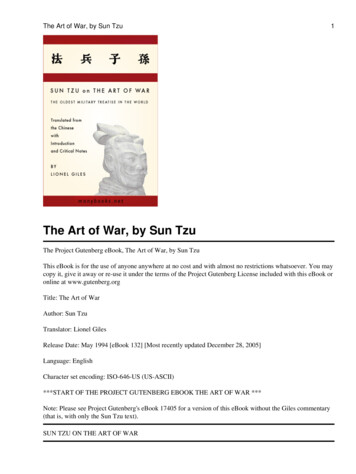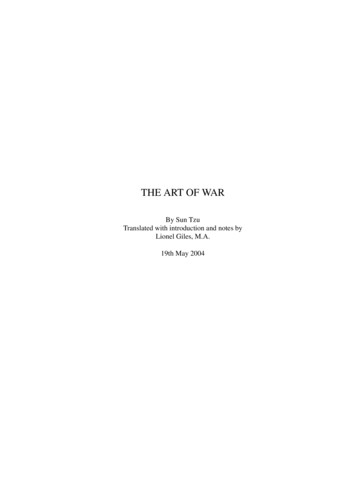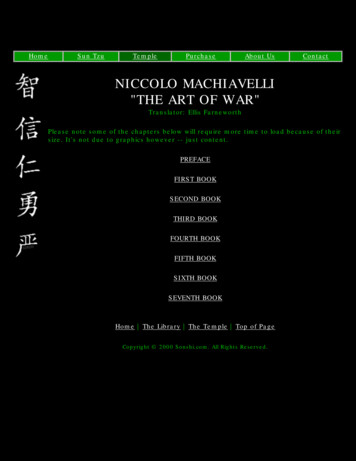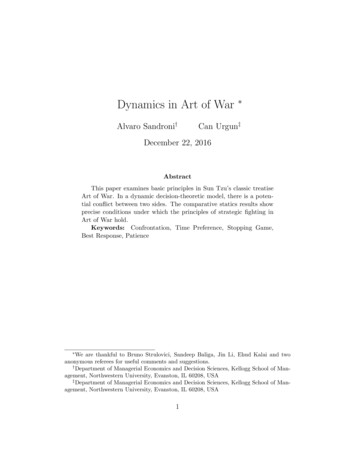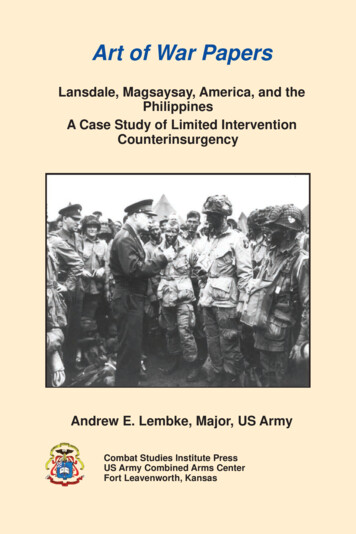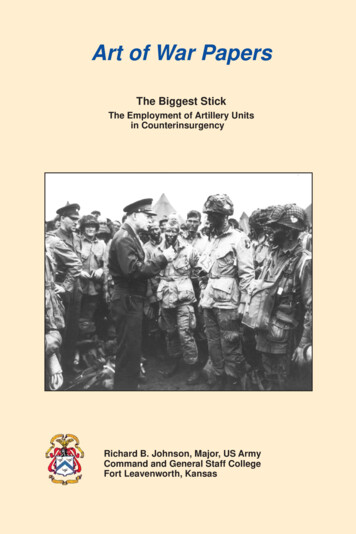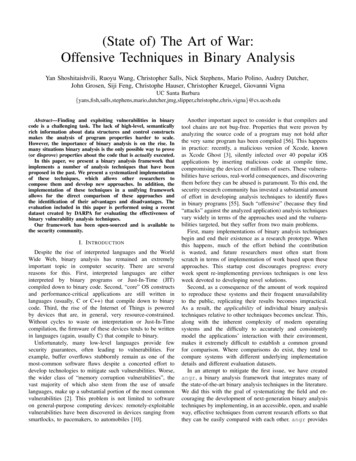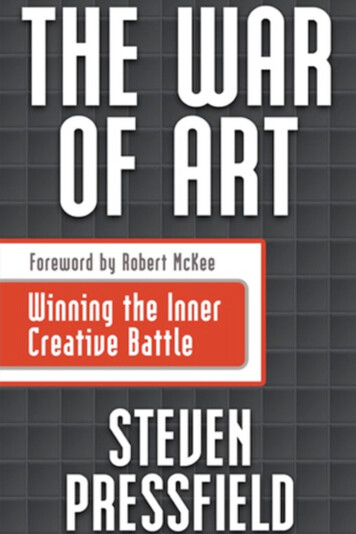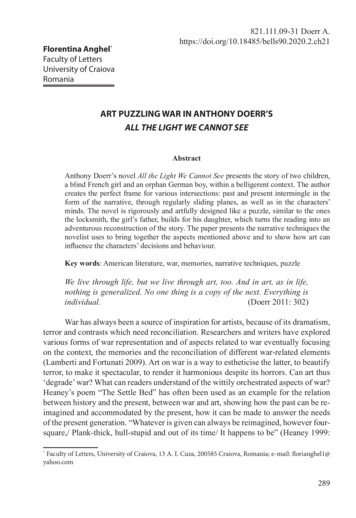
Transcription
Florentina Anghel*1Faculty of LettersUniversity of CraiovaRomania821.111.09-31 Doerr A.https://doi.org/10.18485/bells90.2020.2.ch21ART PUZZLING WAR IN ANTHONY DOERR’SALL THE LIGHT WE CANNOT SEEAbstractAnthony Doerr’s novel All the Light We Cannot See presents the story of two children,a blind French girl and an orphan German boy, within a belligerent context. The authorcreates the perfect frame for various intersections: past and present intermingle in theform of the narrative, through regularly sliding planes, as well as in the characters’minds. The novel is rigorously and artfully designed like a puzzle, similar to the onesthe locksmith, the girl’s father, builds for his daughter, which turns the reading into anadventurous reconstruction of the story. The paper presents the narrative techniques thenovelist uses to bring together the aspects mentioned above and to show how art caninfluence the characters’ decisions and behaviour.Key words: American literature, war, memories, narrative techniques, puzzleWe live through life, but we live through art, too. And in art, as in life,nothing is generalized. No one thing is a copy of the next. Everything isindividual. (Doerr 2011: 302)War has always been a source of inspiration for artists, because of its dramatism,terror and contrasts which need reconciliation. Researchers and writers have exploredvarious forms of war representation and of aspects related to war eventually focusingon the context, the memories and the reconciliation of different war-related elements(Lamberti and Fortunati 2009). Art on war is a way to estheticise the latter, to beautifyterror, to make it spectacular, to render it harmonious despite its horrors. Can art thus‘degrade’ war? What can readers understand of the wittily orchestrated aspects of war?Heaney’s poem “The Settle Bed” has often been used as an example for the relationbetween history and the present, between war and art, showing how the past can be reimagined and accommodated by the present, how it can be made to answer the needsof the present generation. “Whatever is given can always be reimagined, however foursquare,/ Plank-thick, hull-stupid and out of its time/ It happens to be” (Heaney 1999:Faculty of Letters, University of Craiova, 13 A. I. Cuza, 200585 Craiova, Romania; e-mail: florianghel1@yahoo.com*289
Florentina Anghel321). As he states in “The Redress of Poetry”, poetry, therefore art, can counterweightor balance or redress reality in order to reach what he calls, referring to Simone Weil’sGravity and Grace, “some transcendent equilibrium” (Heaney 1995: 15). As Danchevsynthesized, “poetry – art – can function as a kind of moral spirit level, an agent ofequilibration” (Danchev 2009: 1) or “an upright, resistant, and self-bracing entitywithin the general flux and flex” (Heaney 1995: 15). Writing about Heaney’s abovementioned poem, Murphy admits “that one of the enduring values of Heaney’s poetryhas been his willingness to imagine unexpected destinations for the hull-stupid ship ofhistory” (Murphy 2009: 120).Similarly, Anthony Doerr, who majored in history, re-imagines war in his novelAll the Light We Cannot See and embellishes it with magic. The action unfolds duringWorld War II and shifts the reader from one place to another around Europe, especiallyFrance and Germany, while gradually building a counterbalancing path through warand life generated by art. On the one hand the novel has a puzzling structure due toits frequent shifts in time and space, from the characters’ present to their past. Thisstructure is rendered into units of text as separate items and shifts are announced orsuggested in titles, which provides the reader with useful guidance in assembling thepieces of the puzzle. The first chapter entitled “Zero” is also dated 7 August 1944 andcontains the following subchapters: “Leaflets”, “Bombers”, “The Girl”, “The Boy”,“Saint-Malo”, “Number 4 Vauborel”, “Cellar”, “Bombs Away”. It presents the readerwith the context – opening in the middle of the events, protagonists, key places onthe map of the narrative assigned to 1944. The second chapter entitled “One” is set in1934, ten years earlier, and refers to other spaces which represent the titles of severalsubchapters like: “Muséum National d’Histoire Naturelle”, “Zollverein”, “Take UsHome”. Other motifs of the novel are used as peritexts and can be seen as a synthesisof the subordinate texts: “Radio”, “Light”, “The Sea of Flames”, “The principlesof Mechanics”, etc. This explicit fragmentary structure is additional to other inneranachronies that contribute to the authenticity of the narrative flow.On the other hand, the way in which characters are connected to art determinestheir evolution within the larger belligerent context. Subscribing to Doerr’s essay onthe individual experience with the book one is reading, which aims at establishing arelation between art and life, I can say that the novel All the Light We Cannot See is anunexpected and intelligent combination of contradictory elements related to time, toreality and fiction/art, and to different identities contextually shaped. The orchestrationof these elements leads to the idea that art, with a focus on music and fiction in thiscase, contributes to the succession of the events and to the conclusion of the conflict,being an engine for the characters and for the novel. Doerr impersonates his belief inthe individual’s formation through reading books and listening to music by creating290
ART PUZZLING WAR IN ANTHONY DOERR’S ALL THE LIGHT WE CANNOT SEEthe two protagonists of the novel who remain attached to several good memories of thepast related to art, memories that are retained for their stimulating effect.Though generally in psychology, starting with Sigmund Freud’s analysis andtheories concerning childhood memories, such as Psychopathology of Everyday Life,the focus is on the traumatic effect childhood memories can have upon people andon the obsessive return of traumatic past experiences, there are situations when happymoments, also childhood memories, become stimuli for people, helping them to copewith present hardships and guiding them through life. New research in psychologyhas demonstrated that good childhood memories lead to “adaptive developmentand adjustment in adolescence and young adulthood” and may provide good health(Chopick and Edelstein 2019: 84). Thus, memories can act so as to counterweight thepresent situation and create an equilibrium, in the same way art succeeds in grasping the“terrible beauty”, as Yeats calls it in his poem Easter Rising 1916, of a battle or a war.Doerr’s novel is a proof of the role art has for the protagonists, to teach andto delight them, and also an example of how defense mechanisms may act to ensuretheir surviving during the war. For instance, a form of regression can be identified inthe characters’ need to return to their childhood memories or life is understood andtailored through their readings or childhood stories in a form of sublimation.The novel begins with Saint-Malo being bombarded in 1944, the zero moment,with lapidary notes on the setting and short introductions of the two protagonists, MarieLaure – a French blind girl and Werner Pfennig – a German boy, living this experiencein opposite camps. Bewilderment and suspense are created through these flashes ofinformation, apparently not related to each other. It is this disconnectedness that becomesan incentive for the reader to imagine that the fragmentary structure and the different plotlines will converge, solving the initial puzzle in terms of form. The narrative moves onmore planes – the girl’s story, the boy’s and the story of the Sea of Flame in alternation.There is also a movement from the past to the present at a faster pace, covering more years(“One 1934”, “Three June 1940”, etc.) which alternates with a much slower advance inthe 1944 bombardment of Saint-Malo which is rendered through daily account (“Zero7 August 1944”, “Two 8 August 1944”, etc.). All the lines converge to the meeting ofMarie-Laure and Werner when the contrast between the accelerated succession of thepast events and the suspended and almost paralyzing situation of the two protagonistsentrapped in enclosed spaces (a cellar and uncle Etienne’s house) in Saint-Malo iscancelled. These oscillations between past and present, between a fast and a slow rhythmare completed with the oscillation between art and reality.Marie-Laure LeBlanc is the courageous daughter of the locksmith of the Museumof Natural History in Paris. She has learned to manage by herself on the streets inher district due to a model of it made of wood by her father. Monsieur LeBlanc is291
Florentina Anghelthus the artisan that makes a “copy” of the world to help his daughter understand it.His models are instruments that help them cross each other’s worlds, and help herdevelop other skills for orientation in space: thinking and the senses which she willefficiently use later in Saint-Malo during the war. Each short sequence reveals detailsin her life which initially illicit emotion in the reader, but later turn out to contributeto her development. Marie-Laure’s senses and mind are stubbornly and meticulouslysharpened by her father who also cultivates her interest in marine specimens and inadventure books like Jules Verne’s Twenty Thousand Leagues Under the Sea.Her memory is improved as she has to remember space expressed in the numberof steps.Usually Marie-Laure can solve the wooden puzzle boxes her fathercreates for her birthdays. Often they are shaped like houses and containsome hidden trinket. Opening them involves a cunning series of steps:find a seam with your fingernails, slide the bottom to the right, detach aside rail, remove a hidden key from inside the rail, unlock the top, anddiscover a bracelet inside.For her seventh birthday, a tiny wooden chalet stands in the centerof the kitchen table where the sugar bowl ought to be. She slides a hiddendrawer out of the base, finds a hidden compartment beneath the drawer,takes out a wooden key, and slots the key inside the chimney. Inside waitsa square of Swiss chocolate.“Four minutes,” says her father, laughing. “I’ll have to work hardernext year.” (Doerr 2014: 35)Hearing can help her appreciate the distance and smells outline the identity ofplaces and the time of the year.For a long time, though, unlike his puzzle boxes, his model of theirneighborhood makes little sense to her. It is not like the real world. Theminiature intersection of rue de Mirbel and rue Monge, for example, justa block from their apartment, is nothing like the real intersection. The realone presents an amphitheater of noise and fragrance: in the fall it smellsof traffic and castor oil, bread from the bakery, camphor from Avent’spharmacy, delphiniums and sweet peas and roses from the flower stand.On winter days it swims with the odor of roasting chestnuts; on summerevenings it becomes slow and drowsy, full of sleepy conversations andthe scraping of heavy iron chairs.292
ART PUZZLING WAR IN ANTHONY DOERR’S ALL THE LIGHT WE CANNOT SEEBut her father’s model of the same intersection smells only of driedglue and sawdust. Its streets are empty, its pavements static; to her fingers,it serves as little more than a tiny and insufficient facsimile. He persistsin asking Marie-Laure to run her fingers over it, to recognize differenthouses, the angles of streets. (Doerr 2014: 35)Imagination is developed as she has to represent the stories she reads in hermind based on limited images from the real world. Courage and a sense of adventureor a thirst for knowledge and discovery are instilled due to Jules Verne’s novels. Asense of loyalty that makes her help the locals of Saint-Malo during the war may be theresult of her having read The Three Musketeers. She has the profile of a hero borrowedfrom her readings. Her blindness has kept her away from the real world’s ugliness andhelped her see the light in the books she has read, an individual light.The girl’s story is gradually interlaced with the story of the Sea of Flames, ablue diamond that offers its keeper eternal life, but brings misfortune to the world andto all the people that the keeper loves. Whenever someone gets the Sea of Flames, he/she becomes powerful, but also a war is unleashed and many people die. She is toldthe story during a visit to the museum when the guide admits the fact that the stoneis well locked in a room. Knowing that according to the legend the stone was madeby the Goddess of the Earth for her lover, the God of the Sea, and that the curse willend only when it is given to the sea, the girl asks: “Why not [.] just take the diamondand throw it into the sea?” (Doerr, 2014: 23). Thus, the author builds the girl’s portraitand projects a potential action. If Marie-Laure had the stone she would throw it intothe sea, which means that the Sea of Flames should get into her hands to have the warconcluded, therefore the visit to the museum is an anticipatory moment to show thatlegend and war interfere.With the outburst of the war, Marie-Laure’s father is entrusted the diamond, toprotect it from the Nazis, represented here by Sergeant von Rumpel, a treasure hunterfor the Reich. In 1940, when France is invaded, Marie-Laure and her father moveto Saint-Malo to her great-uncle Etienne. Monsieur LeBlanc hides the diamond inthe model of Saint-Malo made for his daughter, the stone eventually gets into MarieLaure’s hands and protects her from the war while her father is arrested and sent to aconcentration camp. The evolution of Marie-Laure and her father, as predicted by thestory of the Sea of Flames, retells the legend but in modern times. At the same timethe legend is a pretext for the economy of the narrative, a mise en abyme symbolicallyencapsulating the whole novel. Instead of simply mentioning some of the reasons atthe back of the war, Doerr uses Sergeant von Rumple who hunts for the magic diamondthat can bring the owner, the Reich here or even himself, power, eternal life and riches.293
Florentina AnghelWhen the diamond gets to Marie-Laure in Doerr’s organization of the events, readersmay expect her to be protected and/or to return the stone to the sea. Marie-Laureherself assumes her granduncle’s house stands during the bombardment due to thestone. Besides magic, it is obvious that the house resists due to Werner’s decision notto give the coordinates that would have made a target of it. The boy protects the beautyof his childhood memory of music and stories.Anthony Doerr weaves the story of the war around the legend of the Sea ofFlames and for the first time hands the powerful stone to an innocent and kind personraised to believe in magic and in science at the same time. His novel demonstrates thateach individual can contribute to the wellness of the world and that common peopleand open-minded children that sapped at the spring of art can make a better world.Werner’s story is presented in parallel – an orphan with a gift to understandand create electric circuits living in Zollverein, a coal-mining town. He finds a radio,repairs it and hears a Frenchman talking about science and broadcasting music. Heis fascinated with the lesson and the music which follow him for the rest of his life.Werner is afraid that he might die like his father in the mine and his gift for radiomechanics helps him get a place at the training school for the Nazi military elite.He succeeds in making a directional radio transceiver and is sent to find those who‘illegally’ transmit information about the German army. His experience with the frontis sickening and traumatizing. He is eventually sent to Saint-Malo and in 1944 hemeets Marie-Laure, whom he protects as he recognizes in her the granddaughter ofthe Frenchman he heard in his childhood. Werner’s love for music hinders him fromcommunicating the coordinates of Etienne’s house, where the radio is. He disobeysthe war orders, with his companion’s complicity, to let the source of his childhood joysurvive. Werner is puzzled by Marie Laure’s broadcasting music and literature, andlets himself be caught by his childhood memories as if he had reached the destination:a return to innocence, a moment when the boy “lives through art”.Doerr shows how apparently insignificant details of the children’s lives can markthem and change the course of the events, which may explain his use of meticulousdescriptions or the emphasis on items that will become relevant later. The atmospherein the novel is upheld through the abundant details and adjectives which seem to digressfrom the course of the main events and relax the atmosphere or soften the impact of theevents like an escape from the cruelty and violence of the war. Doerr gradually buildsa counter world adrift from the harsh reality, a world where music and fiction underpinthe characters’ advance through the horrors of the war.Any shocking event makes the characters retrace the way that led them thereand remember and/or analyse the reasons for which they made their choice. Suchrevisits of the past reiterate details and impressions that the author had carefully294
ART PUZZLING WAR IN ANTHONY DOERR’S ALL THE LIGHT WE CANNOT SEEslipped into the text, which seemed inappropriately minute at the time they happened,but emotionally supportive in time, like landmarks in the characters’ quests forthemselves. According to the characters’ personalities, these details/memories thatrevisit them function differently. For Marie-Laure they are guidelines in the concreteworld that she cannot see but feels and imagines. “Marie-Laure tries to remembereverything she knows about the lock and latch on the gate, everything she has felt withher fingers, everything her father would have told her. Iron rod threaded through threerusted loops, old mortise lock with a rusty cam. Would a gunshot break it?” (Doerr2014: 419). As regards Werner, his memories are recalled to counterbalance his regretsfor having chosen the Nazi school showing that sometimes decisions are contextual,punctual, and incomprehensive.He remembers Frau Elena as she looked early this morning, standing inher nightdress beside the hall lamp, fussing over his bag, all the otherchildren asleep. She seemed lost, dazed, as if she could not absorb howquickly things were changing around her. She said she was proud. Shesaid Werner should do his best. “You’re a smart boy,” she said. “You’lldo well.” She kept adjusting and readjusting his collar. When he said,“It’s only a week,” her eyes filled slowly, as if some internal flood weregradually overwhelming her. (Doerr 2014: 113)Acting in the war is like acting against himself, while protecting his body.Werner’s memories and work help him recreate an inner world to host and protect hismind, being guided by the music he heard when he was a child. Another colleague ofhis, Volkheimer, spends much of his time listening to music, which counterweightsdeath and the terrifying experience at Schulpforta. The beauty of the two children’sminds resists the ugliness of war making of their meeting a reconciliation of theopposite camps, of the products of different spaces and contexts and revealing theimportance of childhood education.Though built like a labyrinth, with a continuous oscillation between Franceand Germany, between the war as experienced by Werner and the threats reachingMarie-Laure’s protective environment, Doerr’s novel is a self-reflexive one. Theembedded stories, Jules Verne’s book that Marie-Laure reads, the legend, the titlesof the subchapters, such as “The Simultaneity of Instances”, and theories like the oneabout enthropy are guidelines for the understanding of the novel. The war is associatedwith randomness and disorder/chaos. When the two children make decisions they livethe illusion of being in control of their lives. Paradoxically Werner and the other boysat Schulpforta are told that the war is meant to cancel disorder even in genes, which295
Florentina Anghelexplains the strict selection of the boys. The contrast between the objectives of thewar (Doerr 2014: 240), according to Hauptmann, and what the war brought in Europeenhances the idea that enthropy is specific to any system, including the social ones.“Disorder. You hear the commandant say it. You hear your bunk masterssay it. There must be order. Life is chaos, gentlemen. And what werepresent is an ordering to that chaos. Even down to the genes. We areordering the evolution of the species. Winnowing out the inferior, theunruly, the chaff. This is the great project of the Reich, the greatest projecthuman beings have ever embarked upon.”Hauptmann writes on the blackboard. The cadets inscribe thewords into their composition books. The entropy of a closed system neverdecreases. Every process must by law decay. (Doerr 2014: 240)Besides, the way in which the novel is organized imitates enthropic disorder andsuggests people’s lack of control. Enthropy can be considered a narrative device Doerruses to render Europe during the war.Within this context, characters make decisions meant to help them survive orfollow their dreams, yet, despite the initial logic, they face unexpected events andchanges that put them in opposite situations and create moments of crisis. Wernerwants a safer and better life and he considers his admission to Schulpforta is anopportunity, but he is only used until Hauptmann obtains the transceiver. Then Werneris sent to the front although he has not finished the training period and is not theright age. Mr LeBlanc decides to leave Paris for Saint-Malo, a smaller town of lessinterest to the forces involved in the war, in his opinion. Yet, Saint-Malo is the placewhere the treasure hunter von Rumpel finds Mr LeBlanc and arrests him, and also themost affected place because of the bombardment. Frederick, Werner’s friend, is sentto Schulpforta by his parents who consider this school an opportunity for his growthand for their social position. He is identified as weaker than the others, beaten andhumiliated. His personality, interests and determination not to ask to leave make himreturn home in a vegetative state he will never recover from. He only reacts when hesees the images of the birds that he used to love so much.The events seem to be randomly orchestrated from beyond man’s will and power.To aesthetically reconcile randomness and reversing situations with the narrative orderhe follows, Doerr uses the legend of the Sea of Flame, literature and music whichcreate emotion, harmony and develop skills that help the characters cope with thewar. Marie-Laure’s blindness is compensated by her sharp senses and courage andalso by the magic power of the diamond that she holds until the danger passes away.296
ART PUZZLING WAR IN ANTHONY DOERR’S ALL THE LIGHT WE CANNOT SEEAs the legend says, the people that she loves die or go through misfortune. Her fatheris probably dead, Werner commits suicide. Her decision to return the stone to the seamakes it impossible for her to check whether eternal life can be reached. It is also areturn to normality as if the stone had launched and maintained the war. Thus the novelitself becomes one of the legends built around the stone, a rewriting of it. ThereforeDoerr’s novel erected among the remains of a terrifying war is an aesthetic attemptto show that art, innocence, beauty and human feelings can never be buried under theruins, but they succeed in making mankind go on.ReferencesChopik, W. J. and R. S. Edelstein (2019). Retrospective Memories of Parental Care andHealth from Mid- to Late Life. Health Psychology, 38(1), 84–93. (4 November2019) http://dx.doi.org/10.1037/hea0000694 .Danchev, A. (2009). On Art and War and Terror. Edinburgh: Edinburgh UniversityPress.Doerr, A. (2011). Books, Memory and the Twelve Bright Stars Scratched Across Page302. NW Book Lovers. (16 May 2018) hedacross-page-302/ .Doerr, A. (2014). All the Light We Cannot See. New York: Scribner.Freud, S. (1995). The Basic Writings of Sigmund Freud (Psychopathology of EverydayLife, the Interpretation of Dreams, and Three Contributions to the Theory ofSex). New York: Modern Library.Heaney, S. (1995). The Redress of Poetry. London: Faber.Heaney, S. (1999). Open Ground. Selected Poems. 1966-1996. New York: Farrar,Straus and Giroux.Lamberti, E. and V. Fortunati. (2009). Memories and Representations of War.Amsterdam and New York: Rodopi.Murphy, A. (2009). Seamus Heaney. Devon: Northcote House Publishers Ltd.297
All the Light We Cannot See and embellishes it with magic. The action unfolds during World War II and shifts the reader from one place to another around Europe, especially France and Germany, while gradually building a counterbalancing path through war and life generated by art.
